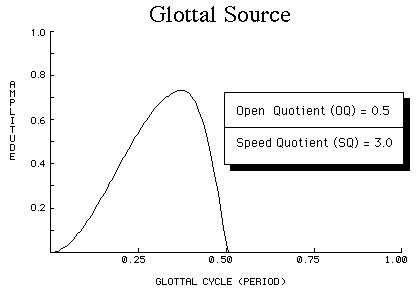Legacy: ASY Glottal Source
A variety of options are available for controlling the glottal source characteristics of the Haskins articulatory synthesis program. The original version of ASY has an extremely limited source model. Other source and aerodynamic models have been incorporated in Haskins' articulatory synthesis programs, including the Ishizaka and Flanagan two-mass model (Ishizaka and Flanagan, 1972), and a full parameteric specification of source control (see B. H. Story, 2005, for an example of an improved model).
In the original ASY model, described here, control of the voice source involves specification of amplitude, fundamental period, and two additional parameters affecting the shape of the glottal volume velocity pulse. Normally, these two parameters specify open quotient (OQ), the ratio of pulse duration to pitch period, and speed quotient (SQ), the ratio of the rising to falling pulse durations. The specific form of this time-domain description uses different polynomial functions for the rising and falling phases, and includes a single slope discontinuity at the end of the open phase. This form was previously found to be most natural in perceptual tests (Rosenberg, 1971). Optionally, the glottal pulse can be specified in the frequency domain as the impulse response of a two-pole filter. In this case, the two input parameters specify the pole frequencies. However, the time domain description is preferred because its input parameters seem more natural and its output produces perceptually better results.
| ASY DEMO | VOWELS | VOCAL TRACT | DYNAMIC SYNTHESIS | INFORMATION |

